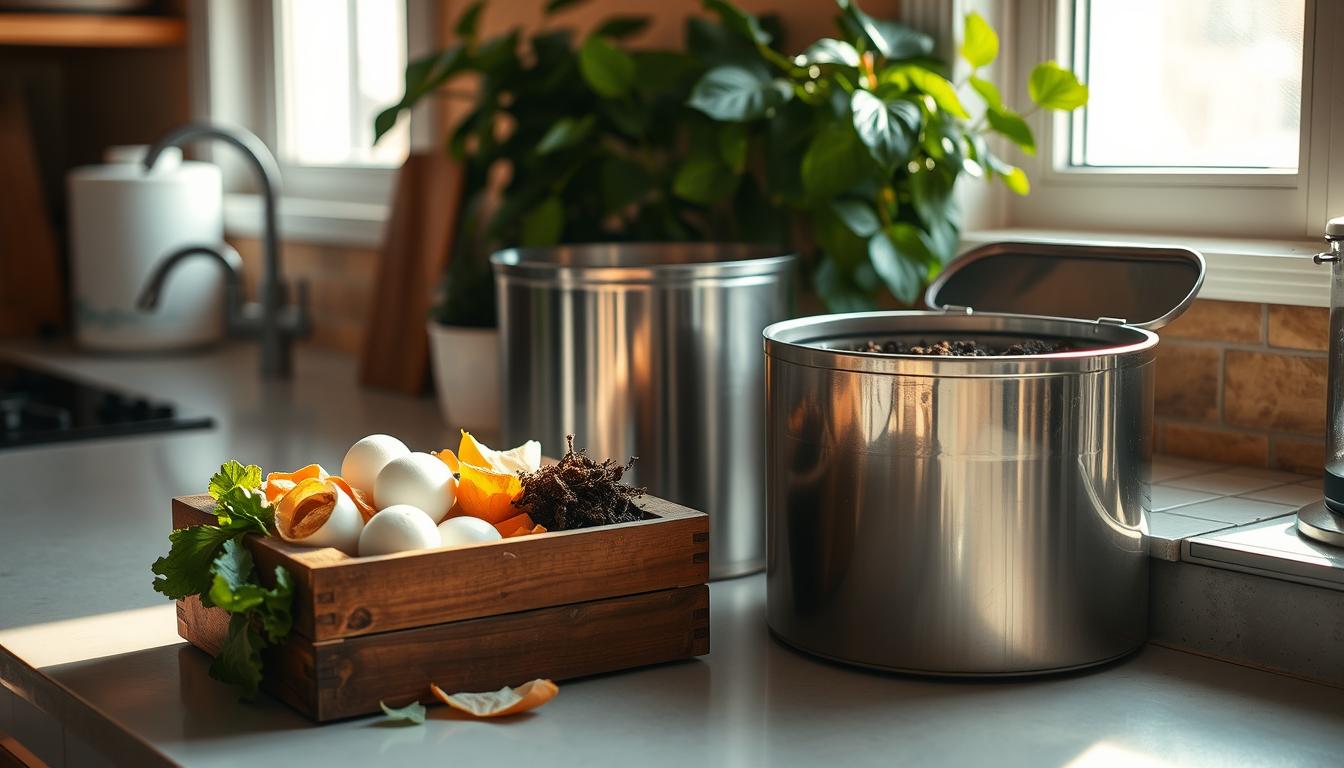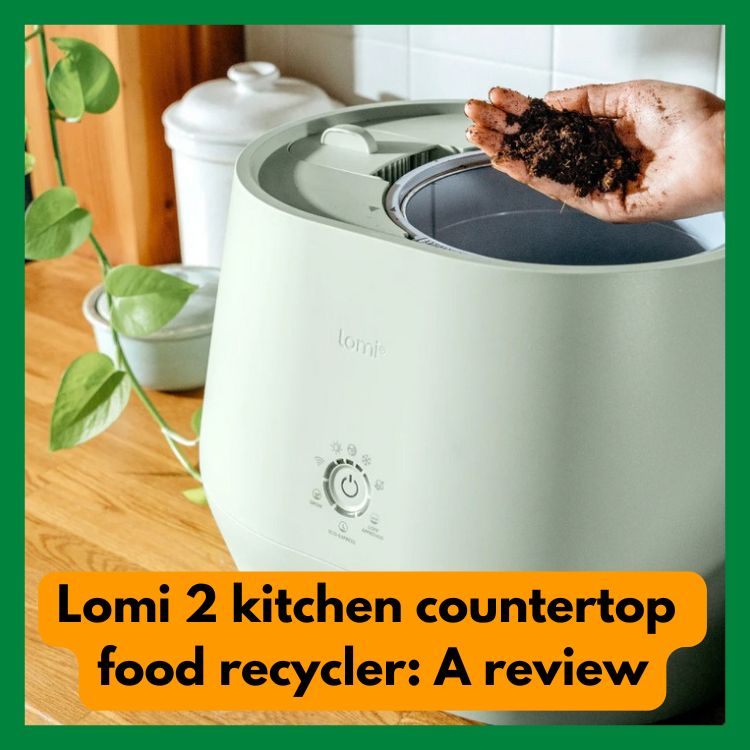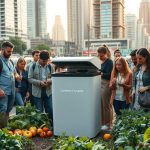Yes, Here’s How
If you want to know the answer to the question, Can I Compost In A Small Backyard? the the answer is a resounding YES!
Did you know the average American throws away about 4.4 pounds of trash daily? A lot of this waste is organic.
Backyard composting is a smart way to cut down on waste and make your garden soil better.
Composting at home is simpler than you might think, even if you have little space.
With small space composting, you can turn kitchen scraps and yard clippings into something good for your plants.

This guide will show you the basics of composting in small backyards. It’s important and doable. You’ll learn how to start and use your organic waste wisely.
Key Takeaways
- Understand the benefits of backyard composting for your garden and the environment.
- Learn simple techniques for small space composting.
- Discover how to turn kitchen scraps and yard waste into nutrient-rich compost.
- Get started with composting at home, regardless of your space constraints.
- Explore the importance of reducing organic waste through composting.
The Benefits of Backyard Composting
Backyard composting helps reduce waste and makes your garden soil better. It’s great for city folks with little space.
It’s an easy way to handle waste and improve soil.
Composting in your backyard is good for the planet. It cuts down on waste going to landfills, which lowers harmful emissions.
Plus, the compost you make is a natural fertilizer. It means you use less chemical fertilizers that harm water.
Environmental Impact of Composting
Composting turns waste into something useful. It keeps organic materials out of landfills, where they’d make methane.
Instead, they become compost that makes soil better for plants and supports good microbes.
What Happens If You Don’t Turn Compost?
Financial Benefits for Homeowners
Composting also saves you money. It means less waste to throw away, which can lower your waste costs.
And, the compost you make means you buy less fertilizer, saving you cash on gardening stuff.
More and more people are composting in cities. They see how turning waste into garden gold helps the planet.
By composting, you help the environment and make your garden better.
Understanding the Composting Process
Composting in small spaces starts with knowing how microbes break down waste. It’s a process where organic materials are decomposed by microbes.
This makes a valuable resource for your garden.
The Science Behind Decomposition
Microorganisms like bacteria and fungi drive decomposition. They eat organic matter, turning it into simpler stuff.
Oxygen is key for these microbes to work well.
Key factors influencing decomposition include:
- Moisture levels
- Oxygen availability
- Carbon-to-nitrogen ratio
- Temperature
The Composting Timeline in Small Spaces
The time it takes to compost can change a lot. It depends on the space and what you’re composting. In small areas, keeping the right mix of materials and moisture is crucial.
Also, turning the compost often helps.
| Composting Stage | Duration | Description |
|---|---|---|
| Initial Decomposition | 1-2 weeks | Microorganisms start breaking down organic matter |
| Active Composting | 2-6 weeks | Compost pile is actively decomposing, requires regular turning |
| Maturation | 1-3 months | Compost matures and becomes ready for use |
Understanding composting helps even in small yards. It turns waste into something good for your garden.
This improves soil health and makes it more fertile.
Can I Compost in a Small Backyard? Debunking Common Myths
You don’t need a big yard to compost. Small spaces can work just as well. Many think composting needs a lot of space, but that’s not true.
With the right tools and techniques, even tiny backyards can compost.
Composting in small backyards is not only possible but also good for the environment. It helps reduce waste and makes soil rich for your garden.
By learning the basics and addressing common worries, you can compost in your small backyard.
Space Requirements: Smaller Than You Think
One big myth about composting is that it needs a lot of space. But, you can start composting with just a small area, like 4×4 feet.
The trick is to pick a composting method that fits your space.
Compact bins or tumblers are great for small backyards. They save space but still allow for air and decomposition.
Vermicomposting, or worm composting, is also good for small spaces. It doesn’t smell and can be done indoors or outdoors.
Addressing Concerns About Odor and Pests
Another worry about composting in small backyards is odors and pests. But, with the right steps, these problems can be solved.
Keeping the right mix of materials, the right moisture, and turning the compost often helps avoid odors.
To keep pests away, don’t add meat, dairy, or oily foods to your compost. These attract pests. Using a compost bin with a tight lid also helps keep pests out.
By following these tips, you can compost in your small backyard without odors or pests.
By clearing up these myths, it’s clear that composting in small backyards is not only possible but also good.
With the right approach, you can enjoy composting benefits, even with limited space.
Choosing the Right Composting Method for Limited Space
Composting at home is key, especially in cities. There are many ways to do it, even with little space.
For small backyards or city living, you need a method that works well. It should be easy on space and keep smells down.
Let’s look at some good options for small spaces.
Bin Composting Systems
Bin composting systems are great for small areas. They keep pests out and smells down. They come in all sizes, fitting any space.
- Advantages: Keeps odors and pests away, easy to turn and care for.
- Considerations: Costs to buy a bin, needs regular upkeep.

Tumbler Composters for Small Yards
Tumbler composters are perfect for small yards. They make turning compost easy, speeding up the process.
- Benefits: Easy to turn, aerates well, can fight pests.
- Things to Consider: Costs upfront, some fit very small spaces.
The Vivosun Tumbler is particularly easy to use
Vermicomposting: Worm Bins for Tiny Spaces
Vermicomposting, or worm composting, is great for tiny spots, even indoors. It uses worms to turn waste into rich compost.
- Advantages: Works indoors, makes great compost, little smell if done right.
- Considerations: Needs a worm bin setup, worms need care.
Knowing these composting methods helps you pick the best one for your space. This way, composting at home can be both easy and rewarding.
Essential Materials and Tools for Small-Space Composting
Composting in small backyards needs the right tools and materials. You can turn organic waste into compost even with little space.
The right equipment makes it easier.
Composting Containers and Bins
Choosing the right container or bin is the first step. You can pick from plastic, metal, or wooden bins. Plastic bins are durable and affordable.
Metal bins look good and last long. Wooden bins add a natural touch to your garden.
Think about size, ventilation, and how easy it is to get to when picking a bin. A 3x3x3 feet bin is best for good air and insulation.
Some bins have special features like turning mechanisms to make composting easier.
Tools for Turning and Maintaining Your Compost
Turning your compost often is key for good air and fast breakdown. Aerating tools like pitchforks or compost turners are must-haves.
A pitchfork is great for gentle turns, while a turner makes it easier.
You’ll also need a shovel or spade for adding stuff and a moisture meter. The right moisture is important for composting well.
Optional Accessories to Improve Efficiency
Some accessories can make composting better. Compost filters or odor absorbers can cut down on bad smells. This is good for small or tight spaces.
Compost aerators or turners also help, making turns easier and compost better.
Compost accelerators or activators can speed up composting. They have microorganisms that help break down waste faster.
They’re great for starting or boosting a slow compost pile.
With the right tools and materials, you can compost efficiently in your small backyard.
You’ll turn waste into something valuable for your garden.
Setting Up Your Small Backyard Composting System
Starting a composting system in a small yard is easy. First, pick the right spot, prepare the ground, and add the first layers.
Knowing the basics is key to a successful composting system in your backyard.
Finding the Ideal Location
Look for a spot that’s easy to get to, gets some sun, and is near water. A well-ventilated area is best for your compost bin.
Some sun is good, but too much can dry it out. A spot with partial shade is perfect.
Make sure your compost area is near water. This helps keep the compost moist. Also, think about how it looks.
You might want to hide the compost bin to keep your yard looking nice.

Preparing the Ground and Container
Before you start, get your ground and container ready. Clean your bin well. For ground composting, clear the area of debris and weeds.
To help things break down, add a layer of coarse materials like twigs or straw at the bottom.
This improves airflow and drainage, making a good base for your compost pile.
Initial Setup and First Layers
Start by adding the first layers. Begin with brown materials like dried leaves or shredded newspaper.
These materials are carbon-rich and help with aeration.
Then, add a layer of green materials like kitchen scraps or grass clippings. Keep alternating between brown and green layers. This balance is key for good composting.
| Layer Type | Materials | Purpose |
|---|---|---|
| Brown Layer | Dried leaves, shredded newspaper | Carbon-rich, aids aeration |
| Green Layer | Kitchen scraps, grass clippings | Nitrogen-rich, promotes decomposition |
By following these steps, you’ll create a great composting system in your small backyard. It’s a great way to manage waste and help your garden grow.
What Can and Cannot Go in Your Compost Pile
Composting at home needs the right mix of materials. You need green (nitrogen-rich) and brown (carbon-rich) stuff.
Some items should not go in the compost pile.
Green Materials: Nitrogen-Rich Ingredients
Green materials are full of nitrogen. They’re key for composting. Here are some examples:
- Fresh grass clippings
- Kitchen scraps like fruit and vegetable peels
- Manure from herbivores
- Fresh leaves
- Green weeds (without seeds)
These items add nitrogen, speeding up composting. But, mix them with brown materials to avoid a wet or smelly pile.
Brown Materials: Carbon-Rich Ingredients
Brown materials are full of carbon. They give energy to microorganisms. Here are some examples:
- Dried leaves
- Shredded newspaper
- Cardboard
- Straw or hay
- Wood ash (from untreated wood)
These materials soak up moisture. They create a carbon-rich environment for decomposition.
Items to Avoid in Small Backyard Composting
Some organic materials should not be composted. They can cause problems. Here are some examples:
- Meat, bones, and dairy products (attract pests)
- Pet waste (can contain pathogens)
- Weeds with seeds (can propagate in compost)
- Diseased or moldy materials
- Chemically treated materials (e.g., pesticides, herbicides)
- Coal or charcoal ash
Staying away from these items keeps your compost pile healthy. It prevents pests and diseases.
Step-by-Step Guide to Maintaining Your Compost
To get the most out of your micro composting system, regular maintenance is key. Maintaining your compost involves a few crucial steps.
These steps ensure the decomposition process is efficient and effective. By following these steps, you’ll create a nutrient-rich compost for your small backyard garden.
Balancing Green and Brown Materials
A well-balanced compost pile needs a mix of green and brown materials. Green materials, like kitchen scraps and grass clippings, are rich in nitrogen. Brown materials, such as dried leaves and straw, are rich in carbon.
Aim for a mix of 2/3 brown materials and 1/3 green materials for optimal decomposition.
To maintain this balance, add green materials like fruit and vegetable peels, tea bags, and coffee grounds. Balance these with brown materials such as shredded newspaper, cardboard, and dried leaves.
Avoid adding too many green materials at once to prevent odors and pests.

Proper Turning Techniques for Small Bins
Regular turning is essential to maintain oxygen flow and speed up decomposition. For small bins, use a compost turner or a pitchfork to gently turn the materials. T
urn the compost pile every 7-10 days to ensure even breakdown.
When turning your compost, be careful not to compact the materials. This can prevent oxygen from reaching the microorganisms.
If you notice any dry or matted areas, break them up to improve airflow.
Monitoring Moisture Levels
The compost pile should be kept moist, like a damp sponge. Excessive moisture can lead to anaerobic conditions and unpleasant odors.
Dry conditions can slow down decomposition. Check the moisture levels regularly by inserting your hand into the compost pile.
If the compost feels dry, add some water. If it’s too wet, add more brown materials to absorb the excess moisture.
Aim for a moisture level that’s consistent throughout the pile.
Managing Compost in Different Seasons
Compost maintenance varies with the seasons. During hot weather, ensure that the compost pile doesn’t dry out. In cold weather, reduce the frequency of turning to prevent heat loss.
In the spring and summer, add more green materials as they become available. In the fall, add more brown materials like leaves and straw.
By adjusting your compost maintenance routine to the season, you’ll keep your compost pile thriving year-round.
Accelerating the Composting Process in Small Spaces
You can make composting in small spaces better by using a few tricks. Composting in tight spots needs smart ways to make good compost fast.
With the right methods, you can turn waste into compost that helps your garden.
Chopping Materials into Smaller Pieces
Chopping your materials into smaller bits helps compost faster. It lets microorganisms work better. For example, cutting kitchen scraps or yard trimmings into smaller pieces speeds up decomposition.
Tip: Use a garden shredder or a sharp knife to chop your compost materials. This simple step can make a big difference in how fast your compost is ready.
Using Compost Activators and Boosters
Compost activators and boosters add needed microorganisms to start or boost composting. They have beneficial bacteria and fungi that help break down materials faster.
When picking a compost activator, choose one with a mix of diverse microorganisms.
Example: Some popular compost activators include those with Trichoderma species. They are known for efficiently decomposing organic matter.
Hot Composting Techniques for Quick Results
Hot composting makes your compost pile hot to speed up decomposition. It needs regular turning and checking moisture levels for the best conditions.
By keeping your compost pile hot, you can get compost in just a few weeks.
To do hot composting, make sure your pile is big enough to stay hot but not too big. Regular turning and the right mix of green and brown materials are key to keeping it hot.
Composting in Different Types of Small Spaces
You don’t need a big backyard to compost. Even the smallest spaces can work well. It just takes some creativity and the right methods.
Patio and Deck Composting Solutions
For patios and decks, look into compact composting systems. They save space and control odors.
These bins or tumblers fit in corners or against walls.
Worm composting, or vermicomposting, is another great choice. It’s small, quiet, and works indoors or outdoors. Perfect for tight spaces.
Balcony Composting Techniques
Balconies can be tough for composting because of wind and odors. Use a well-sealed compost bin or a balcony composter.
They help keep smells down and handle wind.
It’s important to mix green and brown materials right. This stops odors. Also, turn your compost often and check moisture levels.
Side Yard and Corner Lot Strategies
Side yards and corner lots offer more composting chances. You can use regular bins or piles. Just pick a spot that’s easy to get to but not in the way.
Multi-bin composting systems are great for these areas. They let you move materials through different stages. This keeps your composting going smoothly.
With the right composting methods for your small space, you can reduce waste and make nutrient-rich soil.
It’s good for your plants.
Troubleshooting Common Small-Space Composting Problems
Composting in small spaces can be very rewarding. But, problems like odors, pests, and slow decomposition can happen.
Luckily, most of these issues can be fixed with simple changes to your composting routine.
Dealing with Odors in Limited Spaces
Odors in composting often mean there’s an imbalance. To cut down on smells, mix “green” materials (like food scraps) with “brown” materials (like dried leaves).
If smells still bother you, add more brown materials or turn the compost to let in oxygen. As one expert says,
“A well-balanced compost pile should have the earthy smell of a forest floor, not the stench of rotting garbage.”
To lessen odors, you can also:
- Put a layer of finished compost or soil on top to soak up smells
- Mix in a handful of odor-absorbing materials like activated charcoal or baking soda
- Stay away from adding meat, dairy, and oily foods that can cause strong odors
Preventing and Managing Pests
Pests in compost can be rodents or insects. To keep pests away, make sure your compost bin is secure. If pests show up, try:
- Burying new materials under existing compost to keep pests out
- Avoiding meat, dairy, and oily foods that pests like
- Turning the compost pile to disrupt pest homes
For pests that won’t go away, use natural pest control methods.
Try introducing beneficial insects or using diatomaceous earth to keep pests away without harming your compost.
Fixing a Slow Decomposition Process
If your compost is breaking down slowly, several things might be wrong. Check that your compost has the right mix of green and brown materials.
Also, make sure it’s not too dry or too wet. Turning the compost can help by adding oxygen, which is key for decomposition.
To speed up the process, you can:
- Chop materials into smaller pieces before adding them to the compost
- Add compost activators or boosters, such as manure or compost tea
- Keep an eye on and adjust the carbon-to-nitrogen ratio
By solving these common problems, you can keep your composting process healthy and efficient, even in small spaces.
As you keep composting at home, you’ll get better at understanding what your compost needs. This makes managing backyard waste a smooth part of your gardening routine.
Harvesting and Using Your Homemade Compost
When your compost is ready, it’s time to use it in your garden. This makes the soil better for plants.
The compost is full of good microbes that fight diseases and make soil better.
How to Know When Your Compost is Ready
Figuring out when compost is ready can be tricky. But, there are signs to look for. It should smell like earth and feel crumbly.
Most of the original stuff should be gone, except for a few bits.
- Check for an earthy smell: Finished compost should have a pleasant, earthy aroma.
- Look for a uniform texture: The compost should be dark and crumbly, with few recognizable pieces of the original materials.
- Test the temperature: Compost that is ready to use should be close to ambient temperature.
Sifting and Storing Finished Compost
Before using your compost, sift it to remove lumps. Use a compost sifter or wire mesh. Keep it in a dry, covered spot to keep it good.
| Sifting Method | Tools Needed | Benefits |
|---|---|---|
| Manual Sifting | Wire mesh or compost sifter | Cost-effective, allows for manual inspection of compost quality. |
| Mechanical Sifting | Tumbler or mechanized sifter | Faster processing, can handle larger volumes. |
Best Ways to Use Compost in a Small Garden
Compost can make your small garden better in many ways. Here are some top ways to use it:
- Mix into Soil: Blend compost into the soil before planting to improve its fertility and structure.
- Use as Mulch: Apply a layer of compost around plants to retain moisture and suppress weeds.
- Make Compost Tea: Steep compost in water to create a liquid fertilizer that promotes healthy microbial activity.
By following these steps, you can use your homemade compost well. This will make your small garden more productive and sustainable.
Creative Space-Saving Composting Ideas for Urban Yards
You don’t need a big backyard to compost. Urban yards can use creative solutions. Urban gardening is growing, and composting is key for healthy plants in small spaces.
You can compost on a patio, balcony, or tiny yard with innovative methods.
Vertical Composting Solutions
Vertical composting is great for those with little space. Wall-mounted or freestanding vertical composters make composting space-efficient.
These systems have tiers for different composting stages.
Vertical composting saves space and adds style to your garden.
Popular vertical composting options include:
- Wall-mounted compost bins
- Stackable compost containers
- Tiered composting systems
Multi-Purpose Garden Structures with Built-in Composting
Another creative idea is adding composting to garden structures. For example, a garden bench with a compost bin underneath is both a place to sit and compost.
Multi-purpose garden structures like these make the most of your urban yard.
Some ideas for multi-purpose garden structures include:
- Garden benches with compost bins
- Planters with built-in composting compartments
- Outdoor storage units that double as composters
Community Composting Options for Very Limited Spaces
If you have very little space or no yard, community composting is a good option. Many cities have programs where people can contribute organic waste to a shared facility.
Community composting reduces waste and builds community.
“Community composting programs are a great way to engage residents in sustainable practices and reduce the amount of organic waste sent to landfills.” – Urban Gardening Expert
To find community composting in your area, you can:
- Check with your local waste management department
- Search online for community gardens or composting initiatives
- Join local gardening or sustainability groups
Conclusion
You can definitely compost in a small backyard, and it’s easier than you think. By adopting backyard composting practices, you’re not only reducing your waste.
You’re also creating a nutrient-rich soil amendment for your garden.
Composting at home is a simple yet effective way to contribute to a more sustainable environment.
Throughout this article, we’ve explored various methods and tips for composting in limited spaces.
From choosing the right composting method to troubleshooting common problems, you’ve learned how to make the most of your small backyard.
Now, it’s time to put these insights into practice and start composting.
By embracing composting, you’ll be taking a significant step towards a more eco-friendly gardening practice. So, can i compost in a small backyard?
Absolutely, and with the right approach, you’ll be enjoying the benefits of backyard composting in no time.

FAQ
Can I compost in a small backyard?
Yes, you can compost in a small backyard. With the right techniques and equipment, you can turn your small space into a productive composting area. This reduces waste and creates nutrient-rich soil for your garden.
What are the benefits of backyard composting?
Backyard composting has many benefits. It reduces landfill waste and creates nutrient-rich soil. It also saves money on fertilizers and waste disposal.
Plus, it helps fight climate change by reducing greenhouse gas emissions from landfills.
How do I choose the right composting method for my small space?
Choosing the right composting method depends on several factors. These include available space, desired maintenance level, and the type of waste you want to compost.
Popular options include bin composting systems, tumbler composters, and vermicomposting.
What can I compost in my small backyard?
You can compost many materials, like kitchen scraps and yard trimmings. Green materials like food scraps and grass clippings are high in nitrogen.
rown materials like dried leaves and straw are high in carbon. Avoid composting meat, dairy, and pet waste.
How do I maintain my compost pile?
To maintain your compost pile, balance green and brown materials. Turn the pile regularly and monitor moisture levels.
Adjust your composting in different seasons, as temperature and moisture levels affect decomposition.
How can I accelerate the composting process in my small space?
To speed up composting, chop materials into smaller pieces. Use compost activators and boosters.
Try hot composting techniques to quickly decompose materials and produce finished compost.
What are some creative space-saving composting ideas for urban yards?
Creative ideas for urban yards include vertical composting solutions and multi-purpose garden structures with built-in composting.
You can also explore community composting options. These ideas help you compost effectively in small spaces.
How do I troubleshoot common small-space composting problems?
To troubleshoot common problems, identify the issue and take action. For odors, add more brown materials or turn the pile.
To prevent pests, avoid composting meat and dairy, and use pest-proof bins.
How do I know when my compost is ready to use?
Your compost is ready when it’s dark, crumbly, and has an earthy smell. Sift through it to check for uniform texture.
Finished compost improves soil structure and fertility in your garden.
Can I compost on a balcony or patio?
Yes, you can compost on a balcony or patio. Use specialized systems like vermicomposting or compact bins. These methods help you compost in small, urban spaces.






